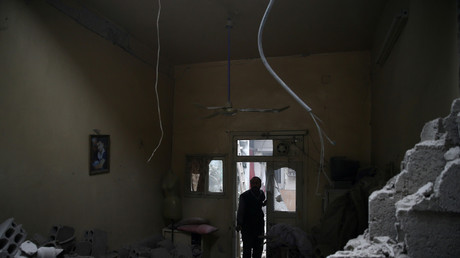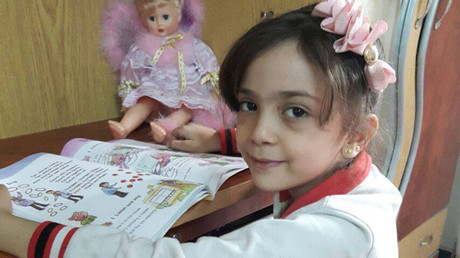‘Truth is the 1st casualty of war’: Syria’s East Ghouta battleground distorted by MSM propaganda
The information battle on the E. Ghouta front is turning into Aleppo 2.0, with Western media, often relying on dubious sources, describing – in unison – the Syrian regime atrocities while nearly glorifying terrorists’ resistance.
Over the last few weeks, mainstream media have simultaneously turned their attention to the ongoing anti-terrorist operation in Eastern Ghouta, a militant-controlled suburb of Damascus, which is seeing a new wave of clashes between Syrian government forces and Islamist factions.
While the army aims to clear the area of such terrorist units as Jaysh al-Islam, Jabhat Fatah al-Sham (formerly known as al-Nusra Front), Ahrar al-Sham and Failaq al-Rahman, Western media, often relying on militant-embedded sources, continue to paint an ominous picture, in which the government troops are deliberately slaughtering civilians.
“Right now we see very concerted Western media attempt to paint the Syrian government as the bad guy, the evil, and giving breathing space for the terrorists who are having the last bastion,” Kaveh Afrasiabi, a former adviser to Iran’s nuclear negotiation team, explained to RT. “The Syrian government has the legitimate security concerns because of the daily shelling of its capital city by the rebels.”
For years now, Al-Qaeda terrorists in #EastGhouta, who have deliberately embedded themselves in civilian areas and denied humanitarian assistance to civilians there, have killed, through mortaring, untold numbers of civilians in Damascus, over a period of years now.
— Dr Marcus Papadopoulos (@DrMarcusP) February 21, 2018
“A naive viewer might imagine that Assad was just bombing civilians for the hell of it because the jihadi fighters are totally absent from the picture. And the pictures are literally provided by the jihadists themselves,” Peter Ford, former UK ambassador to Syria and Bahrain, told RT, referring to the controversial White Helmets, who have long been hailed by the mainstream western media as heroes. However, the UK-backed NGO has long been plagued by allegations of having close ties with terrorist groups.
Before the Syrian government forces intensified operations against jihadist factions in the area, Russia had been trying to broker a deal with armed groups to stop using civilians as human shields and surrender their weapons. Moscow has also been working relentlessly to allow humanitarian aid in. On Thursday, however, Russia had to reject a Western-backed UN resolution for a 30-day ceasefire in Syria as “utopian,” with Russia’s envoy Vassily Nebenzia pointing out that the “propaganda-driven” approach to the coverage of the conflict was only encouraging militants to continue their armed provocations.
“As the saying goes, truth is the first casualty of war,” Afrasiabi laments. The New York Times on Tuesday, for instance, published a piece based on the information provided by the Syrian Observatory for Human Rights (SOHR), a one-man Britain-based war-monitoring group. The piece paints the Assad regime as pure evil, whose only intention is to butcher civilians. The British Guardian newspaper, meanwhile, went as far as to compare the civilian suffering in Eastern Ghouta to Bosnia’s Srebrenica.
Russia has also been repeatedly attacked for the failure of its de-escalation zone initiative and its support of Damascus. Together with Iran and Turkey, Russia is tasked with enforcing the ceasefire in Eastern Ghouta, one of the de-escalation zones established as a result of the Astana talks in May 2017. Despite the ongoing armed provocations, the Russian Center for Reconciliation in Syria enabled the militants to leave the area, but the proposal was rejected.
What is also being downplayed is the Syrian and Russian resolve to end the Ghouta crisis, similar to the one during the Battle of Aleppo, where special corridors were organized to evacuate civilians out of the city, before extending the offer to terrorists for a mass exodus. NYT and the Guardian are not the only western media sources to have shown bias in reporting the events in Eastern Ghouta. A number of experts have pointed out that the Western media coverage of the current events follows a pattern developed in covering the operation to liberate Aleppo, which ended in July 2016.
“We have seen this kind of atrocity level pulled over and over again a few months ago, with Aleppo for example,” Jim Jatras, political analyst, and media and government affairs specialist, told RT. “Every time the Al Qaeda linked groups are on the ropes and the Syrian army is on the verge of liberating territory, then we hear all these horror stories, some of which may have a basis in truth, some not, about how civilians are suffering but nothing on who the terrorists are who are controlling these areas and oppressing the people who live there.”
The Aleppo campaign, initially backed by Russian airstrikes, received mostly one-sided, negative coverage in the Western media, with reporters and politicians accusing Moscow of “war crimes” and causing a “humanitarian disaster,” despite the fact that Moscow and Damascus maintained a 'no-fly zone' over the city. The liberation of the city was presented as its “fall” and “destruction,” as media outlets chose footage of shelled-out buildings rather than scenes of Aleppo civilians celebrating in the streets. Eventually, that narrative fell apart as tens of thousands of refugees started returning to the city and rebuilding of ruined areas began.
CNN promoting a Bana style propaganda operation in #EastGhouta that exploits a clueless 15 yr old. Adult Jihadists force him to read messages he doesn't understand designed to persuade the West to intervene militarily in #Syria. As usual the terrorists are playing western media. pic.twitter.com/HrXCith9j6
— Walid (@walid970721) February 22, 2018
Now the same tactic is being used by the Western media today.This week, CNN used a 15-year-old, Muhammad Najem, and selfie videos he posted on social media, to base their report on the bloody atrocities allegedly committed by the government forces in Damascus suburbs. “The children of Ghouta die every day by the bombing of the Assad regime and Russia,” Najem says, in a segment featured on CNN.
The Syrian boy with flawless English serves as a stark reminder of a seven-year-old Bana al-Abed, who became the “voice” of many civilians trapped under the government siege in Aleppo. While many had only fondness and concern for the Aleppo girl, to others her accounts raised doubt and were seen as a directed propaganda effort.
“We saw this very much with Aleppo. We saw the same kind of coverage from the Western media. Atrocities were being predicted and reported and it turned out that most of those, if not all of them, were actually false propaganda claims. And we are seeing the repeat of this situation again,” Charles Shoebridge, a security analyst and former UK army officer, pointed out.
In a stark contrast, any concern over civilians’ fate miraculously disappeared from Western media coverage during the US-led coalition’s ‘liberation’ of Raqqa and Mosul.
“There was actually no coverage of the situation of Raqqa and Mosul. There were occasional articles,” Shoebridge told RT. “The reason why these things are not being covered is because it is not conducive to supporting UK and US foreign policy which is, of course, still, even now, to destabilize and undermine the Assad government.”
“The Western media are so closely linked to information or misinformation coming out of their governments that it is really misleading the public in the Western countries,” Jim Jatras added.
Real images of destruction from Raqqa and Mosul were there for British and American media outlets to beat the drums of a humanitarian catastrophe. Yet most outlets stayed silent to the indiscriminate bombing of civilians in Syrian and Iraqi cities by the US-led Inherent Resolve coalition. No objection was voiced to the lack of civilian evacuation or the refusal to negotiate a ceasefire with the hardcore Islamists holding civilians as human shields.
“There were no calls ... for a ceasefire to take place” during the British and the American led bombardment of Mosul and of Raqqa, Shoebridge noted. “The US bombardment and sieges of these areas were causing immense suffering and loss of life among civilian populations.” Yet any remote calls to have a ceasefire so that civilians could leave the besieged cities were met with the response “no, this would help terrorists who are occupying that area,” Shoebridge added.
The same selective anti-Assad coverage is continuing in East Ghouta, where the Western media continues to neglect the atrocities committed by the jihadists in the region.
Do I need to remind everyone that jihadis put people in cages using them as human shields in east ghouta
— جعفر (@JaffarAxeman) February 20, 2018
“What the media failed to point out also is that the Islamic State is one of the groups which hold Yarmuk camp, which is one corner of Ghouta, and then you have an affiliate of Al Qaeda which is holding another corner,” former ambassador Ford points out. “So these are really bad guys. Exactly the guys that were wrinkled out of Mosul and Raqqa, with many civilian casualties in the process.”
Think your friends would be interested? Share this story!



